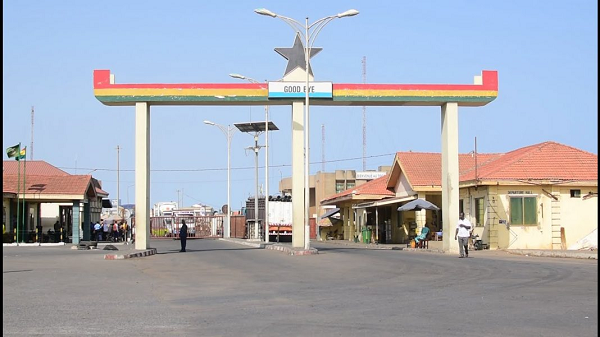Life is gradually picking up at the country’s land borders following their reopening yesterday.
In anticipation of the frontiers becoming buoyant, the Ghana Immigration Service (GIS) has deployed its personnel to the borders.
At the Aflao Border in particular, where we were told about 400 officers have been deployed, business activities were at a slow pace.
That is because Togo is yet to open its side of the border.
Similar observations were made at the borders with Burkina Faso and Cote d’Ivoire, which are also yet to open their sides with Ghana.
Yesterday, the Daily Graphic visited the border points at Aflao, Paga and Elubo to find out how people were responding to President Nana Addo Dankwa Akufo-Addo’s directives last Sunday night for the borders to be opened, two years after they had been closed at the peak of the COVID-19 pandemic.
The reporters who conducted the monitoring were Alberto Mario Noretti, Aflao; Dotsey Koblah Aklorbortu, Elubo; Emmanuel Modey, Hamile, and Gilbert Mawuli Agbey, Paga, Kulungugu and Polimakom.
Background
ECOWAS member states, in December last year, proposed January 1, this year for the reopening of all land borders.
ECOWAS sector ministers, in collaboration with the West African Health Organisation (WAHO), took the decision at a virtual meeting coordinated from Abuja, Nigeria.
Among the factors informing the decision, the ministers took into consideration the fact that their economies lost $50 billion in value or 6.7 per cent of their cumulative Gross Domestic Product (GDP) between 2020 and 2021.
However, the final decision was left with the respective member states, considering their peculiar conditions.
Aflao
There was little activity at the Lome-Aflao border post yesterday, as the Togo side of the border remained closed.
The Daily Graphic, with assistance from officials from both countries, crossed over to Lome and found the border in the Togolese capital as silent as Aflao, with some of the streets devoid of the usual heavy traffic.
Togolese security personnel at the border allowed the Daily Graphic reporter to enter Lome, after they had ascertained his identity as a correspondent of the Daily Graphic, but cautioned him not to go deep into the city.
“The border here is still closed and we don’t know when it will be opened,” one of the Togolese border security personnel said.
However, pupils and students who commute to school between Lome and Aflao are allowed to cross the border freely, and that sustained some light business by taxis and motorcycles.
Border residents who were fully vaccinated against COVID-19 were also allowed the crossing when the Daily Graphic visited the border post before midday yesterday.
Those who were not fully vaccinated were given their remaining jabs at the border post before they were allowed to cross.
Logistics
The metal gates between the two countries were swung wide open to allow trucks of goods and other logistics to cross the border, but the flow of goods between the countries was generally slow.
Daily Graphic checks indicated that the Togolese President, Faure Gnassingbe, would address his country during the week and declare the borders open from Friday, April 1, this year.
Back in Ghana, the Aflao Sector Commander of the GIS, Assistant Commissioner of Immigration (ACI) Fredrick Duodu, said the service was ready for the travellers expected to mass up at the border if the Togo side of the border was opened.
Deployment of GIS personnel
He said 400 officers of the GIS had been deployed at the Aflao Border Post to ensure the smooth movement of travellers.
ACI Duodu said some of the inland GIS posts had been closed with the reopening of the country’s frontiers.
For his part, the Ketu South District Chief Executive (DCE), Maxwell Lugudor, said adequate security measures were in place to forestall a possible surge in crime in Aflao when the Togo side of the border was opened.
As of 1:45 p.m. yesterday, port health officials on the Aflao side had cleared 23 border residents to enter Togo.
Shia
At the border at Shia, near Ho, a female trader who was entering Ghana but had not been vaccinated, was initially asked to return if she was reluctant to take the shot.
However, when she agreed she requested for prayer to be said for her before taking the jab. Her request was granted, she took the jab and crossed over.
At this border, business activities were also slow but officials expressed optimism they would pick up.
A few of the traders, who spoke to the Daily Graphic, called for the neighbouring sides of the borders to be opened to ensure the smooth flow of goods and services.
Shia is one of three border towns within the eastern Ho corridor.
Western Region
At Elubo, barely 24 hours after Ghana had reopened its border with Cote d’Ivoire, economic activities were yet to pick up at the border towns of Elubo and New Town, both in the Jomoro District in the Western Region.
The low level of activities was attributed to the closure of the Cote d’Ivoire side of the border.
Residents of Elubo and New Town said trading with their counterparts from Cote d’Ivoire used to be brisk before the pandemic and admitted that they had to wait until the Cote d’Ivoire side of the border was opened to enable them to assess and see what the future held for them.
Officials of the Customs Division of the Ghana Revenue Authority (GRA), the Ghana Shippers Authority, the GIS, the police, financial services, among others, were all at post.
The DCE for Jomoro, Louisa Iris Arde, was at the entry points in the municipality to assess the situation and interact with the team at the border, during which she assured them of the assembly’s commitment to support them with security.
“We in the municipal assembly are very happy that the borders are finally opened. The President’s announcement was largely greeted with celebration,” she said during a tour of some offices.
The people of Jomoro, she said, were largely traders who transacted business with their counterparts from Cote d’Ivoire and said the closure did not only affect their livelihoods but also social activities.
Mrs Arde urged border control and other security agencies at the entry points to work together as a team to deliver the best of service.
Upper East
Some residents of Paga, Kulungugu and Polimakom, which share borders with Burkina Faso and Togo, received the news of the reopening of the land and sea borders with excitement.
Traders, drivers and other members of the public expressed gratitude to the President for reopening the borders.
According to some traders, the reopening of the borders would bring back economic activities to the towns, which went ‘dead’ during the closure of the borders.
They said with the borders now reopened, they could enter Burkina Faso easily to buy foodstuffs for onward transportation to Accra.
A pepper seller, who gave her name as Fatima Alhassan, said “since the closure of the borders, I have not been able to buy pepper in large quantities to transport to Accra”.
She said her business had been grounded, since she could not cross over to Burkina Faso to buy her commodities.
“I am very elated that the borders have been opened, as it will bring back to life the once vibrant business activities at border communities,” she said.
A resident of Paga, Nouma Alhassan Bukari, said like many other businessmen and women, he was happy that the borders had been reopened, since their closure negatively affected businesses in the area.
The Officer in charge of the Kulungugu border post of GIS in the Pusiga District in the Upper East Region, Chief Superintendent Ebenezer Arhin, said although the borders were reopened just after midnight, vehicular and human traffic, as well as commercial activities, had been slow.
He said a lot of people might not be aware of the reopening or had not anticipated their reopening yesterday.
He expressed optimism that commercial activities would pick up from next week, particularly on market days at Betu, one of the commercial towns in Burkina Faso, as the Ghana side of the border had now been reopened.
Upper West
Business activities at the Hamile border post in the Upper West Region have resumed with the reopening of the borders.
During the period of the closure, the Hamile border post, which is one of the gateways to the Sahel region, was virtually at a standstill, with only a few articulated trucks carrying goods from the Tema Harbour through the border.
But yesterday when a Daily Graphic team visited the place, it observed that business was picking up quickly, with a number of buses and people going through formalities to cross the border.
The Sector Commander of the Customs Division of the GRA, Mr Gabriel Anokye, said information about the opening of the borders had just reached the people, prompting traders and business men and women to troop to the border post to commence their trips.
Among the anxious business people were dealers in vegetables such as onions and tomatoes.
Mr Anokye was optimistic that trading activities would pick up in a week’s time when people would have prepared adequately.
The Hamile border post is the shortest route from Ghana to countries including Guinea, The Gambia, Burkina Faso, Mali and Mauritania.
He gave an assurance that security persons on duty were ready for the growth in business in the coming few weeks.
The sector commander said the security men would be on guard to forestall cross-border crimes.








